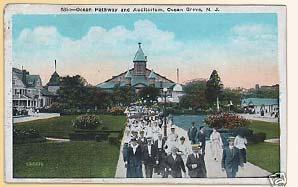How it all Began
The word “chautauqua” is Iroquois and means either “two moccasins tied together” or “jumping fish.” Whatever the precise meaning, it’s clear the word described a lake in western New York which by the Civil War was known as Chautauqua Lake. In 1874, John Heyl Vincent and Lewis Miller rented the site of a Methodist camp meeting to use in the post-camp meeting season as a summer school for Sunday school teachers; this became known as the Chautauqua Institution. This reflected a nation-wide interest in the professionalization of teaching. They were very clear that their intent was educational, rather than revivalist. It should be stressed that the Chautauqua Institution was never affiliated with any one denomination; pretty much every faith group in the U.S. has a chapel or building on the grounds today. Still, the sort of mild Protestantism that has informed much of American culture was an underpinning of the Chautauqua Movement.
The Early Years
Within a few years, the scope of the Chautauqua Institution had broadened to include adult education of all kinds, as well as a correspondence course—the Chautauqua Literary and Scientific Circle, designed to bring “a college outlook” to working and middle-class people. Along with the educational (and education was broadly defined to include the arts and public affairs) offerings at Chautauqua, its thousands of summer residents attended concerts and social activities. By the last decade of the nineteenth century, the Chautauqua Institution was nationally known as a center for rather earnest, but high-minded, activities that aimed at intellectual and moral self-improvement and civic involvement.
Chautauqua Expansion
The Chautauqua Movement, with which the Chautauqua Institution has had a maternal interest but never a formal relationship, grew out of that Chautauqua Literary and Scientific Circle. As its members and graduates spread the Chautauqua idea, many towns—especially in rural areas where opportunities for secondary education were limited—established “chautauquas.” These seasonal establishments were influenced as much by the athenaeums (libraries or institutions for literary and scientific study), mechanics’ institutes, and lecture series “Back East” as they were by the Chautauqua Institution. This reflected the intense desire for self-improvement through education. “Chautauqua” had a strong influence on the rural communities and became shorthand for an organized gathering intended to introduce people to the great ideas, new ideas, and issues of public concern. “Independent chautauquas,” those with permanent buildings and staff could be found throughout the US and Canada by 1900, with a concentration in the mid-West.
After 1900, the “circuit (or traveling) chautauqua” became the principle expression of the movement. The institutional chautauquas were somewhat wary of these travelling, tented chautauquas. Still, at the height of the Chautauqua Movement, about 1915, some 12,000 communities had hosted a chautauqua. Many of the lecturers and performers were contracted by chautauqua agencies—the most notable was the Redpath Agency in Iowa—and the quality of the offerings varied from Vassar-educated lectures and Shakespeare to animal acts and vaudeville farce.
Chautauqua Decline
The movement pretty much died out by the mid-1930s. Most historians cite the rise of the car culture, radio, and movies as the causes. There were several other important, yet subtle, reasons for the decline. One was the sharp increase in fundamentalism and evangelical Christianity in the 20s; the bland non-denominationalism exhibited at most chautauquas couldn’t accommodate these impulses. Many small independent chautauquas became essentially camp meetings or church camps. Another—seemingly contradictory influence—was the rise of the liberated, educated woman. Chautauquas functioned for many lower- and middle-class women much as the elite women’s colleges did for upper-class women. They were training grounds from which women could launch “real” careers. When professional and educational opportunities increased, interest in chautauquas dwindled. Finally, the Depression itself made chautauquas economically impossible for organizers and audiences.
Survival and Rebound
Several independent chautauquas survived and are thriving again while others are being resurrected. The Chautauqua Literary and Scientific Circle continues to this day across the U.S. and Canada. In the U., several state humanities councils have organized “Chautauquas” in the last decade.
In keeping with the spirit of Chautauqua, programs for educators have been organized by universities (the National Science Foundation has also been active in this) and even a chautauqua that travels around the mid-Atlantic states in the summers presenting everything from symposia to strictly entertainment acts.
In Canada, at least 14 Chautauquas exist today across the country, each offering unique programs aligned with one or more of the four pillars. A national organisation, Chautauqua Canada, was established in 2016 to foster communication, connection and a broader sense of community amongst the Canadian chautauquas,
The Chautauqua Movement is alive and well today.
Adapted from content contributed by the Colorado Chautauqua.









